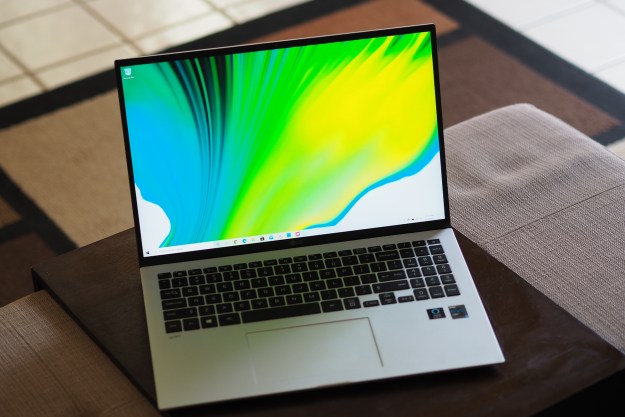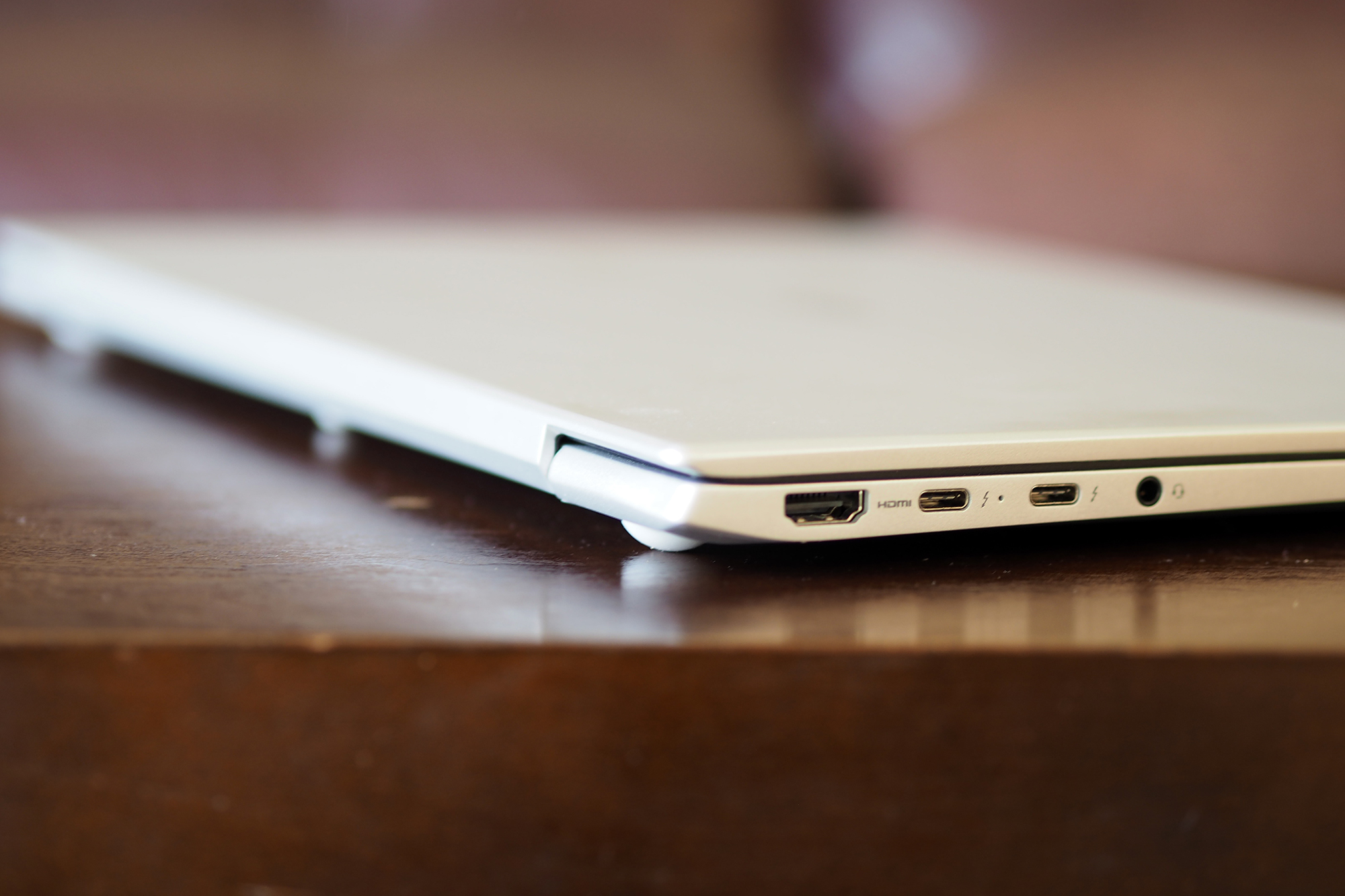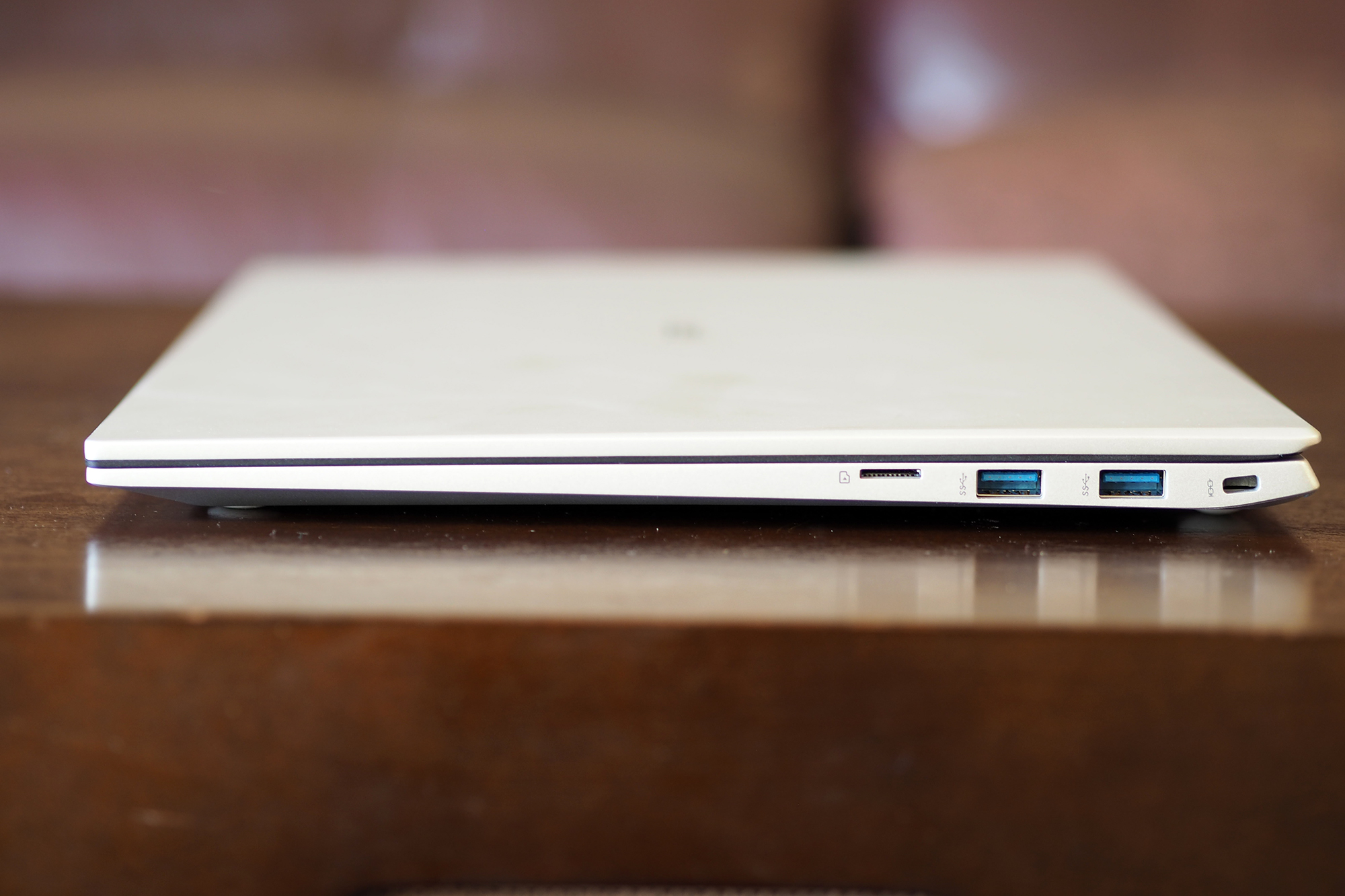
- Incredibly light
- Thin bezels, slim chassis
- Spectacular battery life
- 16:10 display is a boon to productivity
- Well-rounded ports
- Display has inferior contrast
- Lid and keyboard deck are too bendy
- Lacks performance upgrades
The Guinness Book of World Records officially recognizes the LG Gram 16 as the lightest 16-inch laptop. At 2.62 pounds, I’m not surprised it’s earned the distinction.
LG’s Gram laptops have always been designed to be as light as possible (hence the name). That’s as true of the 17-inch model as it is the 13-inch, and across the board, they’re among the lightest laptops you can buy. This year, LG added a new size, the Gram 16, to take on the MacBook Pro 16 and serve as a middle ground between 15- and 17-inch machines.
In the past, LG’s larger laptops have suffered from not offering an increase in power, putting them at odds with
Design

The Gram 16 feels incredibly light. Pick it up and you immediately think it’s empty inside. But it’s not — even at just 2.62 pounds and with a full complement of state-of-the-art components, it still manages to pack in a significant 80 watt-hours of battery.
We’ll cover battery life in depth later on, but suffice it to say that the LG Gram 16 is a battery life champion. The XPS 15 with 86 watt-hours of battery capacity weighs in at 4.5 pounds — and man, can you feel the difference. A larger display and nearly half the weight? I’ll take it.
Note that the MacBook Pro 16 with 100 watt-hours of battery life (the most you can take onto an airliner) weighs 4.3 pounds. Even the much smaller Dell XPS 13 weighs in at 2.8 pounds.
How did LG make the Gram 16 so light? Mainly, it’s the magnesium alloy chassis that trims off the pounds. And it’s not thick magnesium alloy either, which you can tell when you bend the lid with minimal force and push on the keyboard deck until you hit the components below.
Viscerally, the Gram 16 comes across like bendable plastic.
The bottom of the chassis resists flexing, but the rest of the chassis has a lot of give to it. That’s the price you pay to have such a light machine — although LG did subject the laptop to MIL-STD-810G testing to military standards of durability and reliability.
Intellectually, I know this is a robust laptop — maybe not so much as the XPS 15 or the MacBook Pro 16, but it’s not going to blow apart in a stiff breeze. Viscerally, though, it comes across like bendable plastic. Kudos to LG for somehow managing to design the hinge to remain in place and yet still open with one hand. There’s not a lot of weight holding the bottom of the chassis in place.
Thanks to some very small bezels, the Gram 16 is only a bit wider than the XPS 15 at 14.01 inches versus 13.57 inches, with the MacBook Pro 16 coming in at 14.09 inches. It’s a bit deeper at 9.58 inches compared to the XPS 15 at 9.06 inches and the MacBook at 9.68 inches. At 0.66 inches thick, the Gram 16 slots in between the XPS 15’s 0.71 inches and the MacBook Pro 16’s 0.65 inches. The Dell XPS 17 is also in the same ballpark thanks to its tiny bezels and a very slim design — 14.74 inches wide, 9.76 inches deep, 0.77 inches thick, and 5.53 pounds with a 97 watt-hour battery.
Putting it more simply, these are very similarly sized laptops, and they all look quite modern. The Gram 16 is the plainest of the group, though, with its simple silver chassis and complete lack of adornments. That’s on purpose — LG describes it as a “minimalist straight-lined design” intended to “reduce distractions.”
Both the XPS 15 and 17 with their sleeker lines and the MacBook Pro 16 with its understated elegance are better-looking machines. Note that the Gram 16 is also available in white and black color schemes — those might add a bit of panache.
Ports and connectivity
Connectivity is a strength, with two USB-C ports with Thunderbolt 4 support, two USB-A 3.2 ports, a full-size HDMI port, a microSD card reader, and a 3.5mm audio jack. That beats the XPS 15, which has two USB-C Thunderbolt 3 ports, a single USB-C 3.1 port, and no HDMI port.
The MacBook Pro 16 is all-in on Thunderbolt 3 ports, with four of them.
The Gram 16 also enjoys Wi-Fi 6 and Bluetooth 5.1 for up-to-date wireless connectivity.
Performance
The Gram 16 I reviewed used the Core i7-1165G7, a popular Tiger Lake processor that provides solid productivity performance and can dip into low-end content creation. As most manufacturers have been doing lately, LG provides a utility that allows switching between quiet, optimal, and performance modes. Switching between them adjusts performance against fan noise, and in the case of the Gram 16, you’ll want to make use of the utility.
The use of a U-series CPU is important here — most larger laptops, like the Dell XPS 15 and 17 and MacBook Pro 16, use 45-watt H-series CPUs that are much faster for the creative pros who typically choose
In optimal mode, the Gram 16 is an underwhelming performer. As with most such utilities, this didn’t show up in Geekbench 5, where there wasn’t much difference between modes — the Gram 16 is a solid performer in this benchmark, coming in a few points above laptops like the Dell XPS 13 and the Razer Book 13 (which uses the faster Core i7-1185G7). The XPS 15 and MacBook Pro 16 use 45-watt 10th-gen H-series CPUs and, as mentioned, are much faster as a result.
In our Handbrake test, though, which encodes a 420MB video as H.265, the Gram 16 took over 3.5 minutes in optimal mode and just under three minutes in performance mode. Both scores are within about 10 seconds of the Dell XPS 13, and faster than most other laptops with the same CPU. The XPS 15 finished in just over two minutes. We didn’t test the MacBook Pro 16 using the same version of Handbrake and so can’t provide that comparison.

In Cinebench R23, the Gram 16 was slow at 4,137 in multi-core mode and 1,394 in single-core mode in the optimal setting. That’s well behind laptops like the XPS 13 and Razer Book 13. In performance mode, though, the scores jumped to 4,718 and 1,415. These aren’t the fastest we’ve seen — the HP Spectre x360 14, for example, scored 4,847 and 1,404 in its performance mode — but it’s in line with the rest of the field. We didn’t test either the XPS 15 or the MacBook Pro 16 in Cinebench R23, but we guarantee they’d both be faster thanks to their more powerful CPUs.
Don’t buy this laptop expecting powerhouse performance.
Finally, I ran PCMark 10’s Complete benchmark and didn’t see much difference between optimal and performance modes. The Gram 16 scored 4,887 in performance mode in the overall score, and 9,687, 6,886, and 4,749 in the Essentials, Productivity, and Content Creation tests, respectively. These scores are good for the CPU, with the Spectre x360 14, for example, scoring 4,796, 9760, 6340, and 4,837.

Overall, the Gram 16 provided snappy performance throughout my testing. It’s exactly what I expected to see in a laptop with its specifications, and I never experienced anything that gave me pause about the laptop’s performance even in optimal mode — with one exception.
That exception is regarding the Intel Iris Xe, which should provide gaming performance close to an entry-level discrete GPU like the NVIDIA GeForce MX350. Here, the Gram 16’s optimal mode fell well short, scoring just 1,390 in 3DMark’s Time Spy test. That compares to the XPS 13’s 1,589 in its equivalent mode and is well behind most other Intel Iris Xe laptops. Switch to performance mode, though, and the score jumped to 1,801, well ahead of most other Tiger Lake
In Fortnite, the Gram 16 managed only 13 frames per second (fps) in 1080p and high graphics — most Intel Iris Xe laptops topped 30 fps with the same settings. In performance mode, the Gram 16 hit 33 fps, which is only average for the class but much better than in optimal mode.
I didn’t bother test the Gram 16 using our creative content benchmarks because of the lack of discrete graphics and lower-wattage CPU. It just can’t compete with the XPS 15 and 17 and MacBook Pro 16 for creative professionals, which is one of the primary demographics of larger-screen laptops. Don’t buy this laptop expecting powerhouse performance.
Display
Laptops with taller displays — 16:10 or 3:2 — are increasingly common, and it won’t be long before the old-school 16:9 widescreen display is in the minority. The Gram 16 features a 16-inch 16:10 display running at a WQXGA (2,560 x 1,600) resolution. Thanks to small bezels, you’re immediately faced with a large, luxurious expanse for getting real work done.
Unfortunately, the panel itself is a mixed bag compared to other premium laptops. On the one hand, it enjoys a wide color gamut at 88% of AdobeRGB (75% is closer to average for all but the best displays) and 100% of sRGB. But those colors aren’t particularly accurate at a DeltaE of just 2.67 (1.0 or less is considered excellent). The XPS 15’s 4K display came in at 0.65 and the MacBook Pro 16 managed 1.41.

The display’s brightness came in at 313 nits, just meeting our preferred 300-nit threshold. The XPS 15 4K put out 442 nits and the MacBook Pro 16 was a nit brighter than the Dell at 443 nits. Where the Gram 16’s display really suffers is in its contrast, which was just 830:1. Good premium displays these days exceed a 1,000:1 contrast ratio — the XPS 15
I enjoyed the Gram 16’s display for its size and aspect ratio, and I was fine with its colors and brightness — but then again, I’m not a creative pro, so wide and accurate colors aren’t that important to me. I noticed the low contrast, though, because black text didn’t pop the way I like against white backgrounds. Even so, most people will find the display to be pleasant enough for their productivity work and media consumption.
Audio quality was just OK, with sufficient volume for YouTube and the occasional Netflix binge and without significant distortion. Mids and highs were clear, but bass was missing. The XPS 15 and MacBook Pro 16 offer better sound quality, particularly the MacBook, which boasts some of the best audio quality you’ll find on a laptop.
Keyboard and touchpad
The Gram 16 has a fairly typical island keyboard with nicely consistent backlighting. The black keycaps are a good size and have comfortable spacing, and the switches are precise, with plenty of travel and a comfortable bottoming action. My only problem with the mechanism is the amount of pressure needed to engage a keypress — the keyboard felt stiff to me, in contrast to the crisp and snappy action on the HP Spectre line and the MacBook’s Magic Keyboard. If you like a lighter touch, then you might not prefer this keyboard.

The touchpad is large due to the expansive keyboard deck — although there’s space for an even larger touchpad. Its surface is smooth and comfortable for swiping and has excellent Windows 10 multitouch gesture support courtesy of Microsoft’s Precision touchpad drivers. I liked the touchpad quite a bit and appreciated the relatively quiet buttonless clicks. What I didn’t like was the nontouch display — I much prefer touch displays for scrolling with my thumb, which is even more helpful on a taller display.
Windows 10 Hello support is provided by a fingerprint reader built into the power button. It logged me in quickly and painlessly, without a single failure to recognize my finger. I would have liked to have had facial recognition as well, but LG chose not to include it.
Battery life
As mentioned before, the Gram 16 manages to pack in 80 watt-hours of battery capacity despite its incredibly light weight. At the same time, it has a fast CPU and a high-resolution 16-inch display. I wasn’t too sure what kind of battery life to expect.
What I certainly didn’t expect is some of the best battery life we’ve seen. In all our tests, the Gram 16 lasted an exceptionally long time, coming in either as the longest-lasting laptop or in the top tier.
Starting with the PCMark 10 Gaming test that stresses the CPU and GPU, the Gram 16 lasted for five hours. The next-closest laptop is the XPS 13 Full HD+ that lasted a full hour less. In the PCMark 10 Applications test that’s the best measure of productivity longevity, the Gram 16 managed almost 18 hours, which is more than three hours longer than the next best, Lenovo’s Yoga 9i 14. In third place is the XPS 13 at just under 11 hours.

In our web-browsing test, which loops through a series of popular websites, the Gram 16 made it to almost 14 hours. Among Intel laptops, only the Samsung Galaxy Flex 13 came close (in fact, it lasted exactly as long). Only ARM-based
Finally, the Gram 16 lasted for roughly 24.5 hours in our video test that loops through a Full HD Avengers trailer. The Lenovo Yoga 640 with a 10th-gen Core i3 is the closest competitor at 23 hours, and the Dell Latitude 7410 2-in-1 with its low-power display lasted for just under 22 hours. Again, you have to switch to an ARM processor to get better battery life in this test. As with our web-browsing test, the XPS 15 trailed at just over seven hours, and the XPS 17 lasted over nine hours.
Simply put, the Gram 16 exhibited spectacular battery life. In fact, it was a real pain to review — I had to wait over 60 hours for all the battery tests to complete. For the typical productivity user, though, you’ll likely make it through two full workdays before needing to plug in.
Our take
The LG Gram 16 is almost unbelievably light to have such an expansive display and incredibly long battery life. I wasn’t enamored with the keyboard, and the best performance required turning on performance mode and putting up with a bit of fan noise. But I could live with those flaws to have a laptop that I wouldn’t have to worry about plugging in for days and that I’d barely notice in my backpack.
My biggest issue with the laptop, though, is how flimsy it feels. I don’t want to overstate things — the laptop feels robust unless you purposely twist the display or press harder than usual on the keyboard deck. But we do these things in reviews and so we notice them. Whether the typical user would notice — or care, given that the laptop meets military specifications for robustness — is an open question.
Are there any alternatives?
The Dell XPS 15 offers a display that’s also in the 16:10 aspect ratio and provides much better quality in its 4K variant. It’s also almost twice as heavy even though its display is a bit smaller, and it can’t come close to matching the Gram 16’s battery life. You’ll also pay about $300 more for a similarly equipped XPS 15.
Next up is the Apple MacBook Pro 16, which has a more elegant look and feel, as well as a much better display and spectacular sound. It’s also much more expensive, and it, too, can’t come close to matching the Gram 16’s longevity.
Finally, you can get a slightly larger display with the XPS 17, and much faster performance, in a package that’s only slightly larger than the Gram 16. You’ll spend more money, though, and again, battery life will suffer.
The XPS 15 and 17 and the MacBook Pro 16 are also much faster than the Gram 16 thanks to more powerful 45-watt CPUs and discrete GPUs. That’s something to consider when you’re choosing between those two options and the lightest and longest-lasting laptop in this class.
How long will it last?
I’ve already said it — the Gram 16 doesn’t feel like it’s as robust as many other premium laptops if you go looking for flaws. If you trust the MIL-STD-810G rating, though, you can feel confident that it will withstand some abuse. It’s covered by the industry standard — and too short — one-year warranty.
Should you buy it?
Yes. The LG Gram 16 is a solid productivity performer with stellar — really, unparalleled — battery life, and it’s so darn light. Just make sure you note the performance differences compared to other similarly sized laptops.





